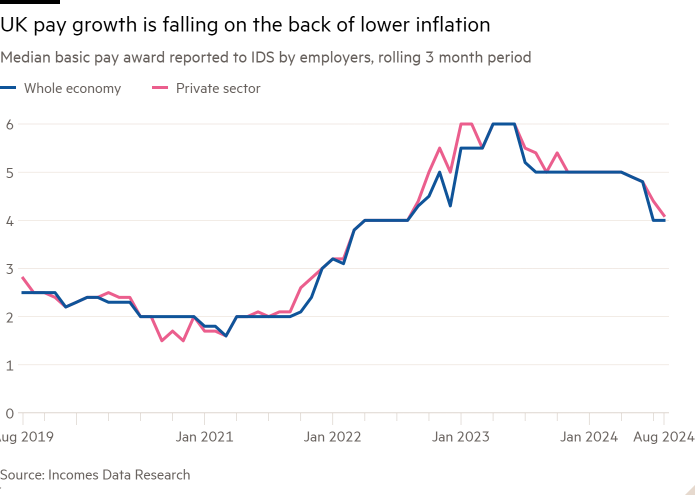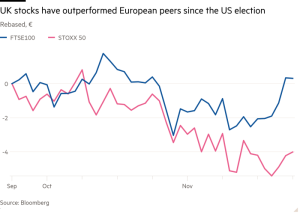Cooling UK labour market brings down wage growth

Stay informed with free updates
Simply sign up to the UK employment myFT Digest — delivered directly to your inbox.
The cooling UK labour market is continuing to bring down wage growth, according to new data that will help to reassure the Bank of England that price pressures are easing.
The median pay award in the private sector fell from 4.4 per cent in the three months to July to a two-year low of 4.1 per cent in the three months to August, according to new figures published on Wednesday by Incomes Data Research.
A pick-up in public sector pay growth meant the median award across the economy as a whole remained stable — a rise of 4 per cent.
Zoe Woolacott, senior researcher at IDR, said the public sector was “currently in the catching-up phase, after a lengthy period in which pay awards lagged behind those in the private sector”. But she added that if inflation fell further, “pay awards are likely to follow it, eventually”.
IDR’s figures corroborate similar data published by the research group Brightmine last week, which showed most annual pay awards were bunched around the 4 per cent mark in the three months to August, with fewer employers handing out bumper payouts.
Sheila Atwood, content manager at Brightmine, said this was due not only to the recent fall in inflation, but also reflected a weaker labour market where “the number of under- or unemployed individuals is starting to outpace the number of job openings”.
The BoE is keeping a close watch on these indicators of pay growth, as well as on official earnings data and its own business surveys, as it seeks to gauge how far inflationary pressures in the economy are easing.
UK inflation held steady at 2.2 per cent in August — far below its 2022 peak above 11 per cent and close to the BoE’s 2 per cent target. But services price inflation has edged up and this week’s increase in regulated energy prices means headline inflation is also likely to rise at the end of the year.
The BoE left interest rates unchanged last month, after August’s cut to 5 per cent, with governor Andrew Bailey arguing that for inflation to stay low, “we need to be careful not to cut too fast or by too much”.
The more hawkish members of the Bank’s monetary policy committee worry that the pandemic and energy crisis might have triggered a lasting change in the way the UK labour market behaves, with workers able to bargain harder against a backdrop of staff scarcity, and businesses better able to pass on costs to consumers.

Official data shows that UK average earnings growth, excluding bonuses, slowed to 5.1 per cent in the three months to May — down from last year’s peak, but still well above recent norms.
However, the labour shortages that fuelled wages over the past two years have now dissipated. Adzuna, the job search engine, said last week that competition for jobs was at its highest level in three years, with more than two jobseekers for every vacancy after the number of jobs advertised in August fell 17.5 per cent compared to a year earlier.
Tony Wilson, director at the Institute for Employment Studies, said that with competition for jobs “returning to more normal levels” and employers “filling their jobs pretty quickly”, this “should give the Bank of England a bit more confidence on future interest rate cuts”.
Economists at Goldman Sachs said on Tuesday that there was “significant room for private sector pay growth to normalise now that price inflation has fallen” but that it was still likely to remain above long-run averages, with public sector wage growth also set to remain firm on the back of recent pay deals.
#Cooling #labour #market #brings #wage #growth





